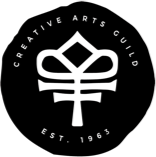Robert T. Webb Sculpture Garden
 Hello. I'm Robert Webb. Thank you for visiting the sculpture garden here at the Creative Arts Guild. This garden is for everyone. The works gathered here represent many forms of modern and contemporary sculpture. You may find that you like some better than others, and that's why we offer a wide range of work: so that many people will find something that they enjoy. The sculptures in the garden are mostly "abstract" or "non-representational." That means that the artist chose not to create a sculpture that looked like something in nature, like a person or a tree. Sometimes people will ask "what is it supposed to be?" It's just supposed to be a sculpture. Anything that you see in it is fine. It may not be the artist's intention, but if you connect with the work in a way that allows you to see something there, then you're just being an engaged viewer. While works made from metal and stone seem durable, they actually can be quite fragile. Please help us to protect these works for generations to come by not touching them or sitting on them. I hope you'll enjoy your time here at the sculpture garden, and I encourage you to visit the exhibits on display at the Creative Arts Guild, as well. Thank you!
Hello. I'm Robert Webb. Thank you for visiting the sculpture garden here at the Creative Arts Guild. This garden is for everyone. The works gathered here represent many forms of modern and contemporary sculpture. You may find that you like some better than others, and that's why we offer a wide range of work: so that many people will find something that they enjoy. The sculptures in the garden are mostly "abstract" or "non-representational." That means that the artist chose not to create a sculpture that looked like something in nature, like a person or a tree. Sometimes people will ask "what is it supposed to be?" It's just supposed to be a sculpture. Anything that you see in it is fine. It may not be the artist's intention, but if you connect with the work in a way that allows you to see something there, then you're just being an engaged viewer. While works made from metal and stone seem durable, they actually can be quite fragile. Please help us to protect these works for generations to come by not touching them or sitting on them. I hope you'll enjoy your time here at the sculpture garden, and I encourage you to visit the exhibits on display at the Creative Arts Guild, as well. Thank you!
NEW ADDITIONS TO THE SCULPTURE GARDEN IN HONOR OF ITS 10TH ANNIVERSARY
KEN & MYRA WHITE MAGNOLIA CRESCENT
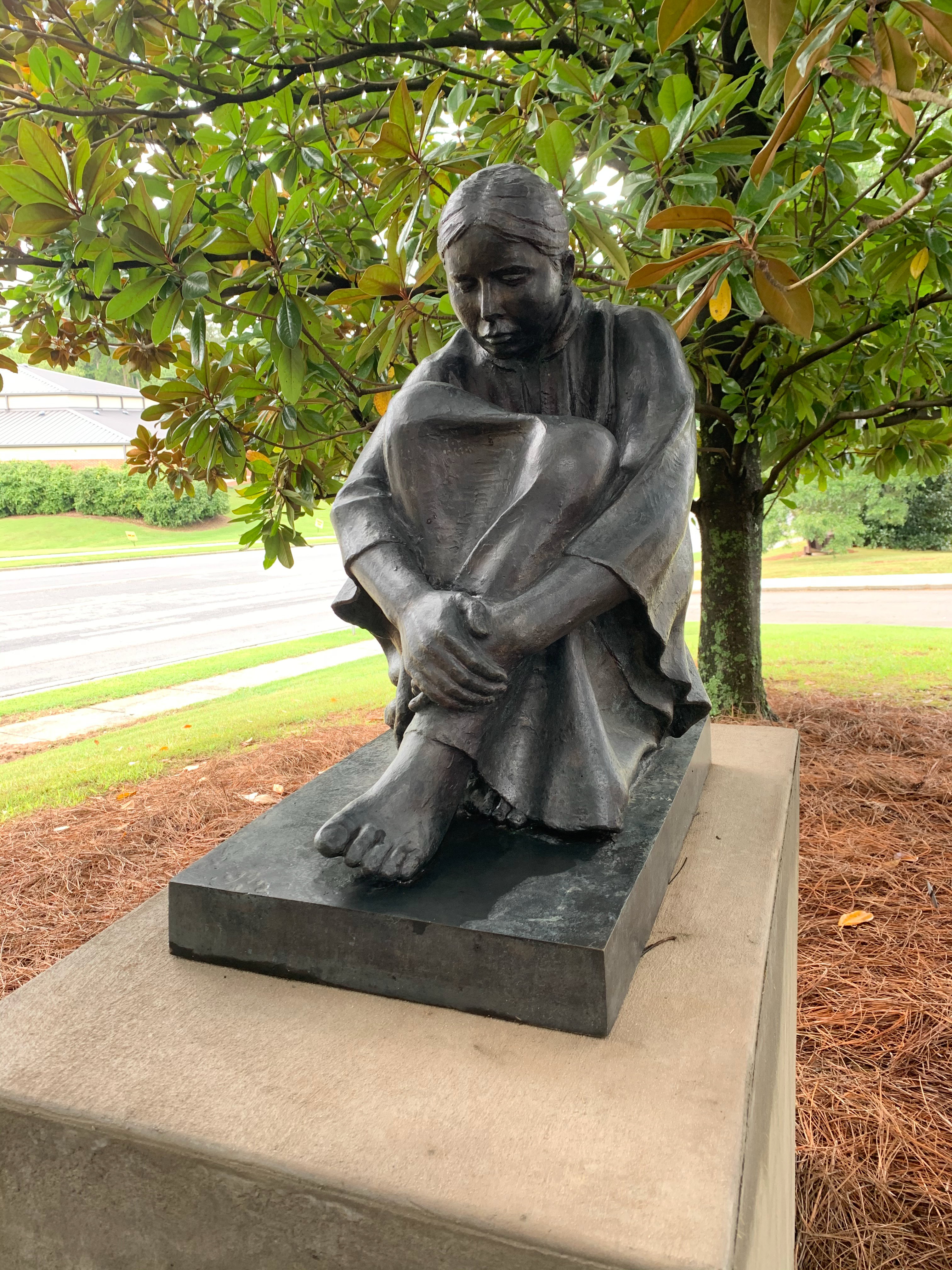
Reflection
Felipé Castañeda (Mexico, 1933 - )
Trained under the master of modern Mexican sculpture, Francisco Zuniga, Castaneda has become universally acclaimed for his interpretation of the female form in every stage of life and in every aspect of the human condition: individual growth; family ties; friendships; love and personal and vocational fulfillment. Strongly influenced by pre-Columbian artifacts he encountered early in his career at the National Museum of Anthropology, Castaneda poses his figures to evoke the art of ancient Middle America. His work in bronze and stone is represented in numerous museum collections in both Mexico and the U.S. Reflection captures a moment of quiet contemplation, and one can only imagine what concerns are the focus of the figure's thoughts.
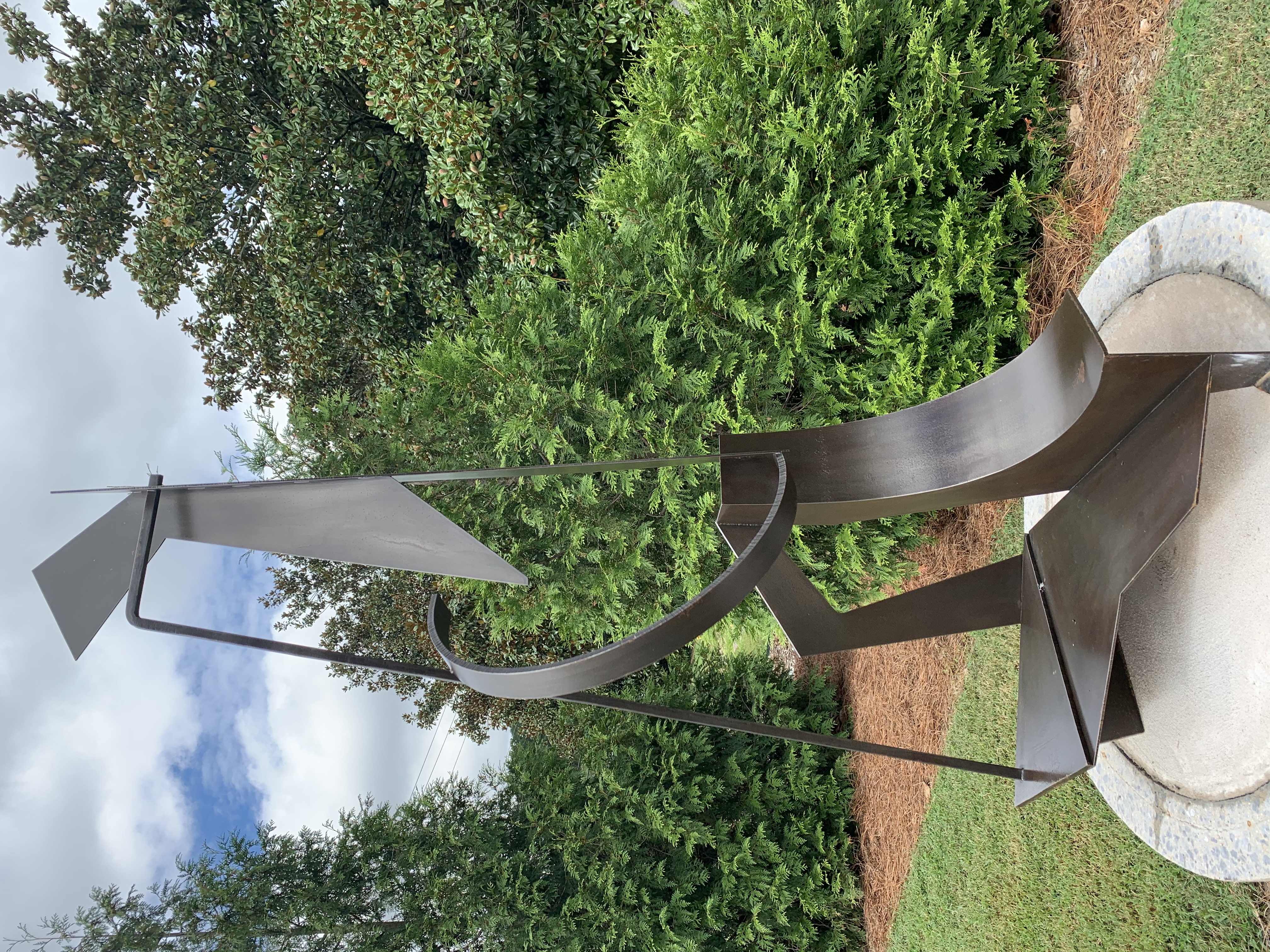 Untitled
Untitled
James Rosati (United States, 1911-1988)
Rosati's monumental sculptures appear in more than 40 cities in the U.S. and internationally, and his work is included in most major collections of modern art. His career began at the start of the Abstract Expressionist movement in post-War New York City, and he shifted from carved stone to the welded steel pieces for which he earned his greatest acclaim. He is recognized for the precision of his geometric pieces and his ability to create a sense of effortless grace in steel. This tabletop piece from the 1970s came from a collection in the Hamptons and complements our existing examples of welded steel work. It is a beautifully balanced composition that marries form, line and open spaces to create a powerful upward thrust.
ELI ROSEN MEMORIAL GARDEN
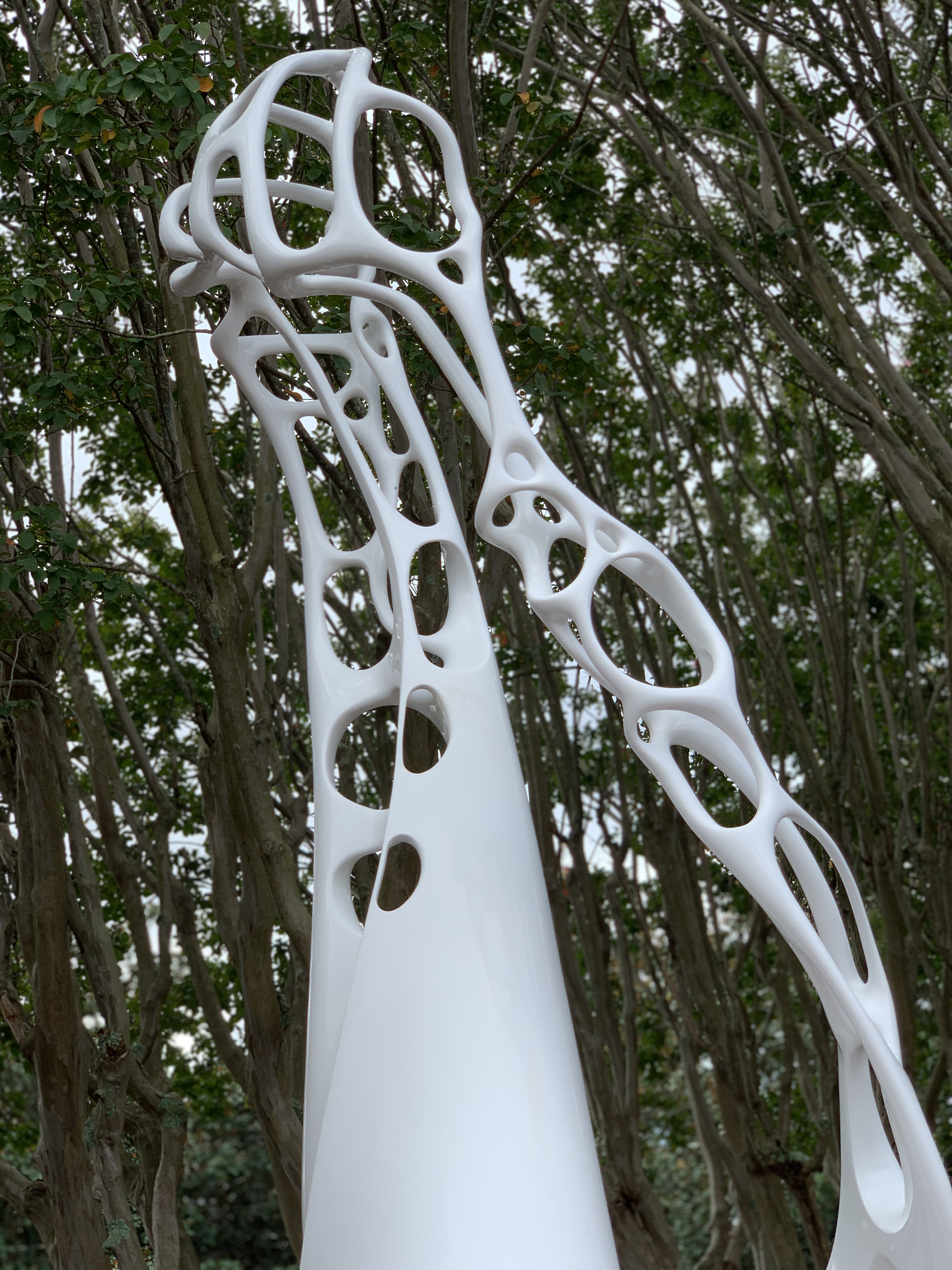 Two Swans
Two Swans
Don Frost (Canada, 1950 - )
Don Frost's artwork combines traditional training in sculptural techniques with an exploration of technology that allows him to achieve unique forms of expression. Frost is colorblind and can only see primary colors, a condition that predetermined that his artistic pursuits would be sculptural rather than painterly. Two Swans is an example of his use of leading edge technology: the work is molded from polyurethane and coated in fiberglass, yielding a perfectly smooth finish, intricately detailed latticework, and a sense of fluidity. Standing ten feet tall, the piece weighs less than 100 lbs. Frost has a history of pushing the envelope. He created the tallest sculpture in Canada in 1983, produced works for two royal families in the Middle East, and placed public works on three continents. Shapemaker: The Sculptor Don Frost, a documentary about his work, premiered at the 2017 Canada China International Film Festival in Montreal. Two Swans is the work with which Frost is photographed in his website's biographical section.
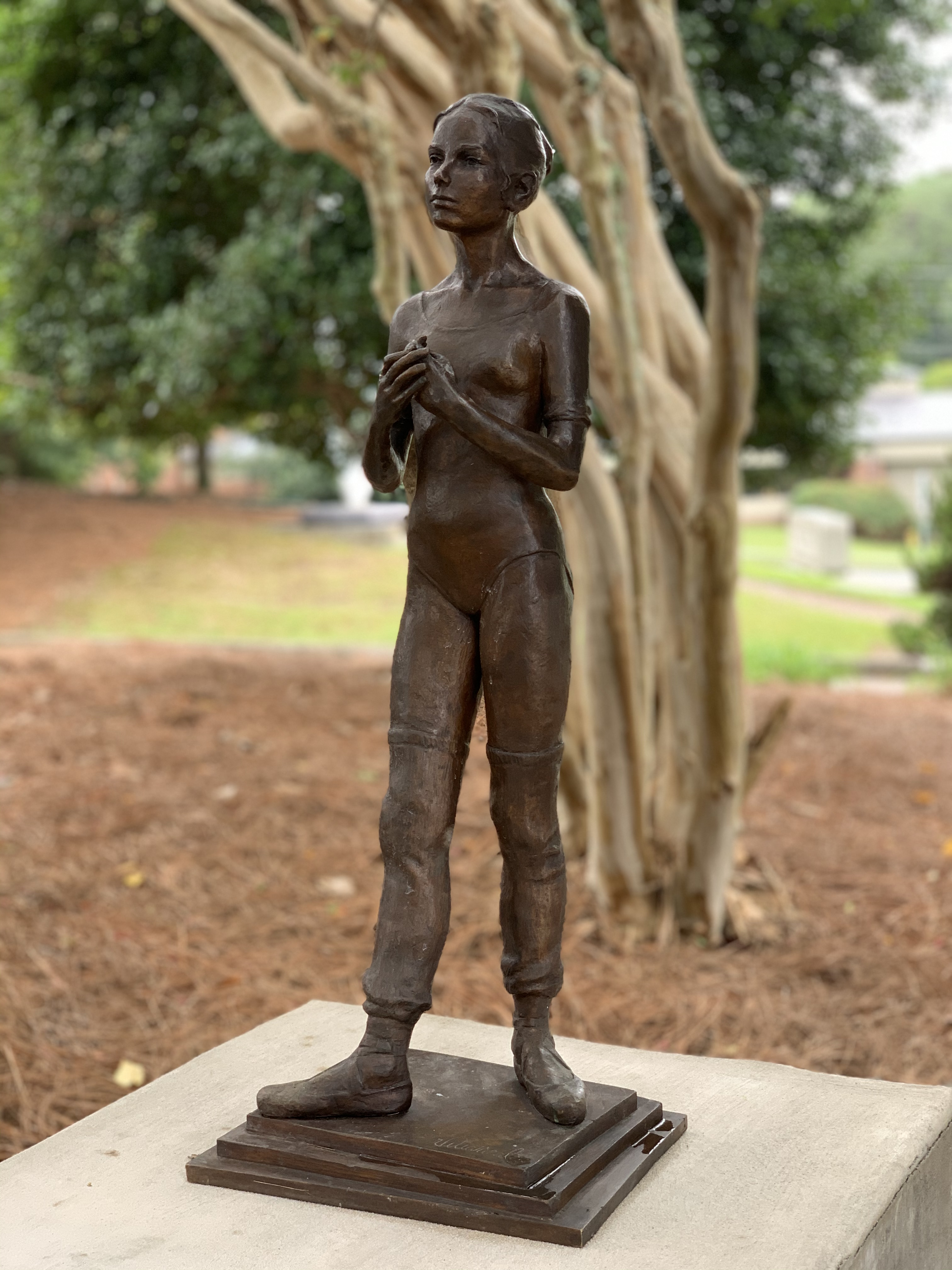 Warming Up
Warming Up
Victor Manuel Villarreal (Mexico, 1944 - )
Famed in Mexico as ''el escultor de bailarinas" (the sculptor of ballerinas), Villarreal has spent a lifetime capturing dancers at rest and in motion. He believes that dance presents the human body at its most graceful, and he meticulously details the nuance and subtlety of the dancers' personalities as well as their creative expressions. In Warming Up, Villarreal focuses on the dancer's poise and posture as well as the intensity of her face as she prepares to commit herself to a rehearsal. Villarreal has produced works ranging in size from one foot to larger than life size. Warming Up is the perfect scale to inspire the imagination of young dancers and reflects the Creative Arts Guild's long history of training dancers.
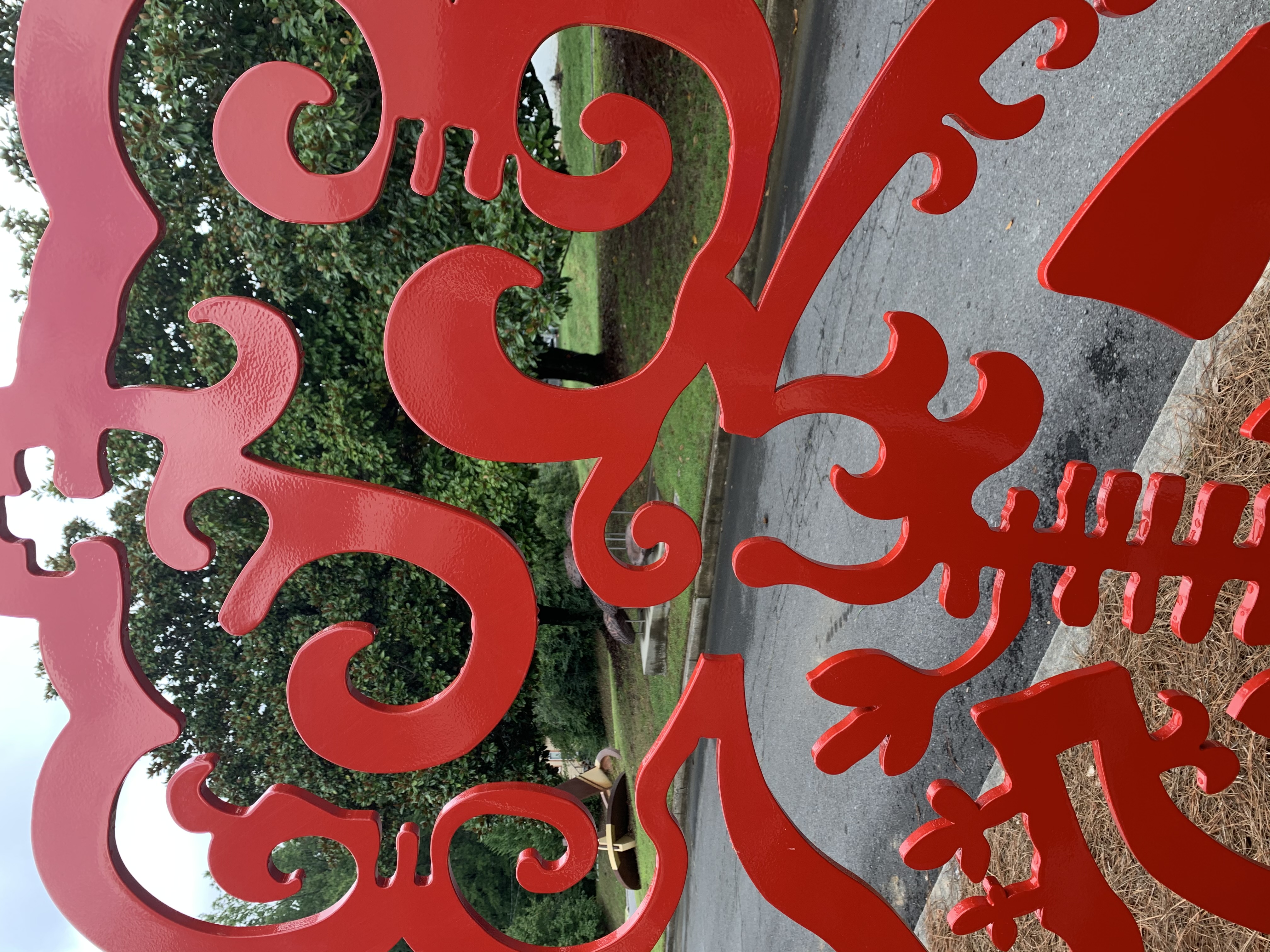
 Strength from Within, Pollen Keeper II
Strength from Within, Pollen Keeper II
Melanie Yazzie (American/Diné Navajo People, 1966 - )
A sculptor, printmaker, photographer, and painter, Yazzie's work educates people about the experience of one indigenous woman, her cultural heritage, and the heritage of indigenous people around the globe. In 2012, Yazzie was named artist-in-residence at the Denver Art Museum. In 2014, the University of New Mexico Art Museum debuted Geographies of Memory, the largest retrospective of her work in two decades. Additional solo exhibits followed at the University of Denver Museum of Anthropology (2015) and the Wheelwright Museum of the American Indian (Santa Fe, NM; 2018). Strength from Within reflects her philosophy that "what we create must have beauty and harmony from within ourselves, from above, below, in front, behind and from our core," hence the transparent nature of the figure, richly adorned with symbols that reinforce that her culture lives on through her. Pollen Keeper II reflects the Diné belief that pollen brings the blessings of peace, happiness, and prosperity. The sculpture also suggests Diné sand paintings of figures, bringing an ancient tradition into a contemporary form.
FOUNDERS GARDEN
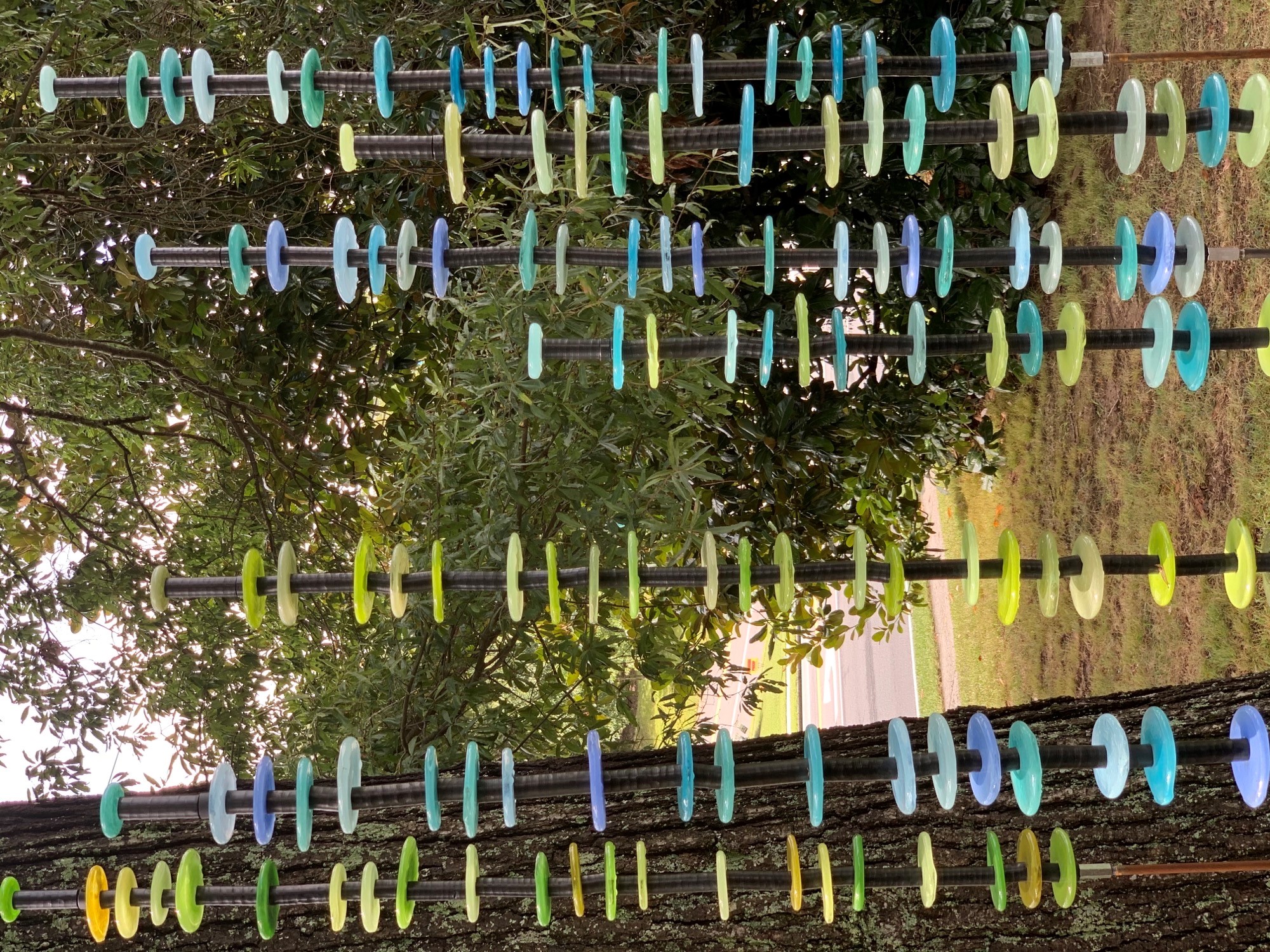 Standing Grove in Blues and Greens
Standing Grove in Blues and Greens
Susan Rankin (Canada, 1959 - )
Standing Grove is the first glass sculpture in the garden and is sited amid shrubs and under towering live oaks to emphasize the organic impression that the work creates, which belies its highly technical creation. Rankin produces both traditional vases and conceptional sculpture. Her work has been honored by the Ontario Arts Council and the Canada Council. Her work is included in collections in Canada, the U.S. and Europe, including the prestigious Corning Museum, the Winnipeg Art Gallery, the Montreal Museum of Fine Arts and the Flemish Center for Contemporary Art. Standing Grove highlights Rankin's sensitive and nuanced use of color and form, with each glass disc as unique and distinctive as a leaf and yet perfectly harmonious when viewed from a distance.
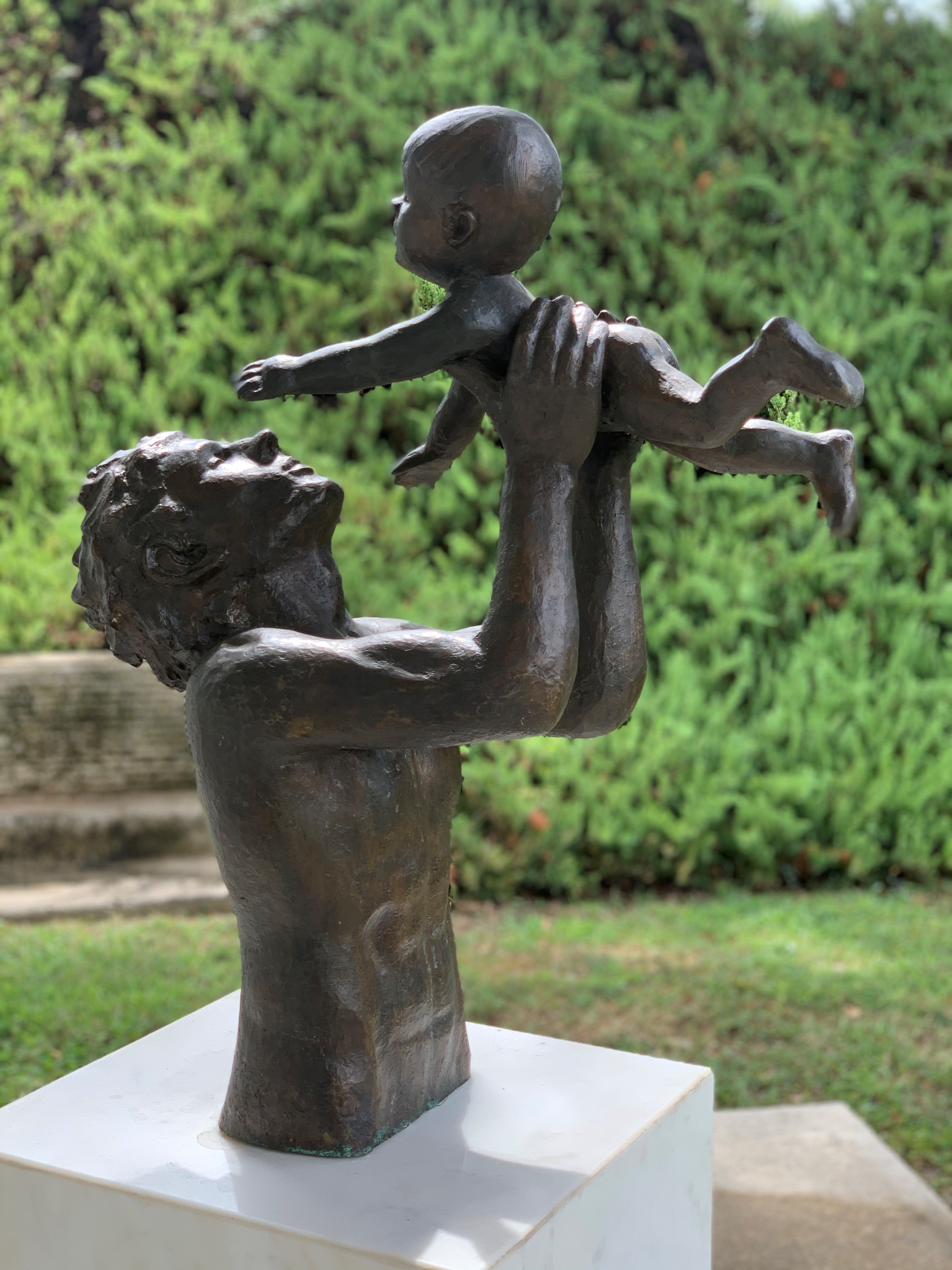 First Born
First Born
Victor Salmones (Mexico, 1937-1989)
In his relatively short life, Salmones established an international reputation as a prominent sculptor of the human form, blending a refined technique with expressive modeling and emotional depth. His work is in the collections of museums, corporations, universities and sculpture gardens in more than 30 countries. Having lost his father early in life and working to support his family from a young age, Salmones began to explore themes of familial love, compassion and humanity that he expressed through figurative works that are both intensively personal and universally accessible. In First Born, the miracle of birth is celebrated through the sheer joy of a new father. The work's intricate composition is a technically impressive example of the lost wax technique the artist used to fashion his bronze sculptures ranging from small editioned pieces to larger-than-life public monuments. Salmones later revisited the theme of the "first born" in the 1971 sculpture First Born Son, which is displayed at the entrance of the Children's Museum in San Antonio, Texas. In that work, the child, now a toddler, sits astride his father's shoulders and hugs his father's head.
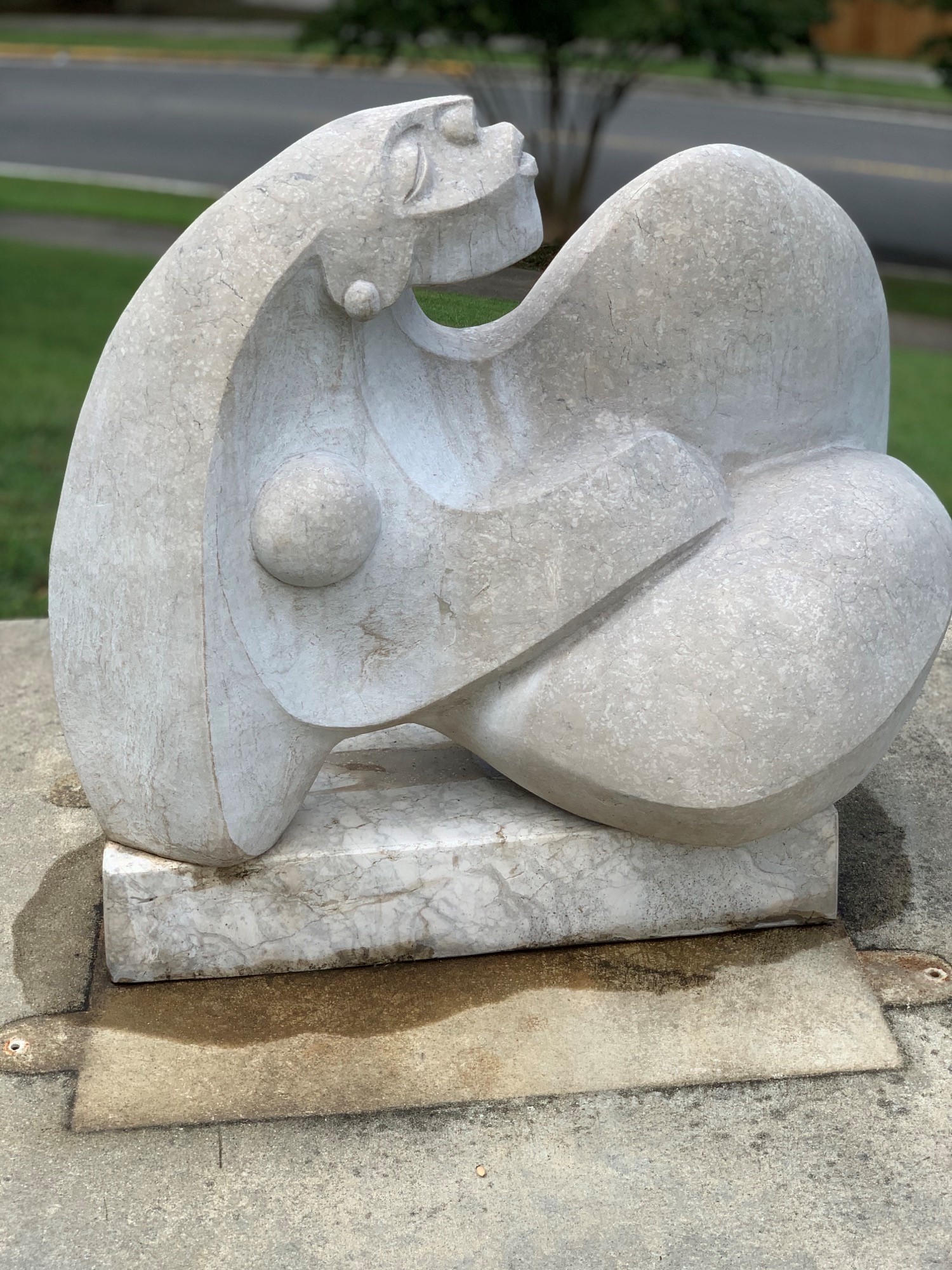 Reclining Nude
Reclining Nude
Ulises Jiménez Obregón (Costa Rica, 1953 - )
As a poor child, Obregón created his own toys by carving them from wood with a machete. Now, in his 60s, he has become a highly prolific artist with more than 600 sculptures in stone, wood and metal in collections around the world. He has exhibited in Central and South America, the U.S., Canada and Mexico and throughout Europe, Asia and the Middle East, including solo shows at a number of museums, universities and embassies. In his figurative paintings and sculptures, he is known for using the same face, broken down into straight lines, squares, rectangles and curves. That female visage has become his trademark, an immediately identifiable characteristic of his work. His work is inspired by the landscape of his native Costa Rica, and Reclining Nude is an excellent example of how he blends the figure with the topography of his homeland. An intriguing mix of Cubism and the pre-Columbian art of Middle America, the beautifully carved piece perfectly balances the modern and the ancient.
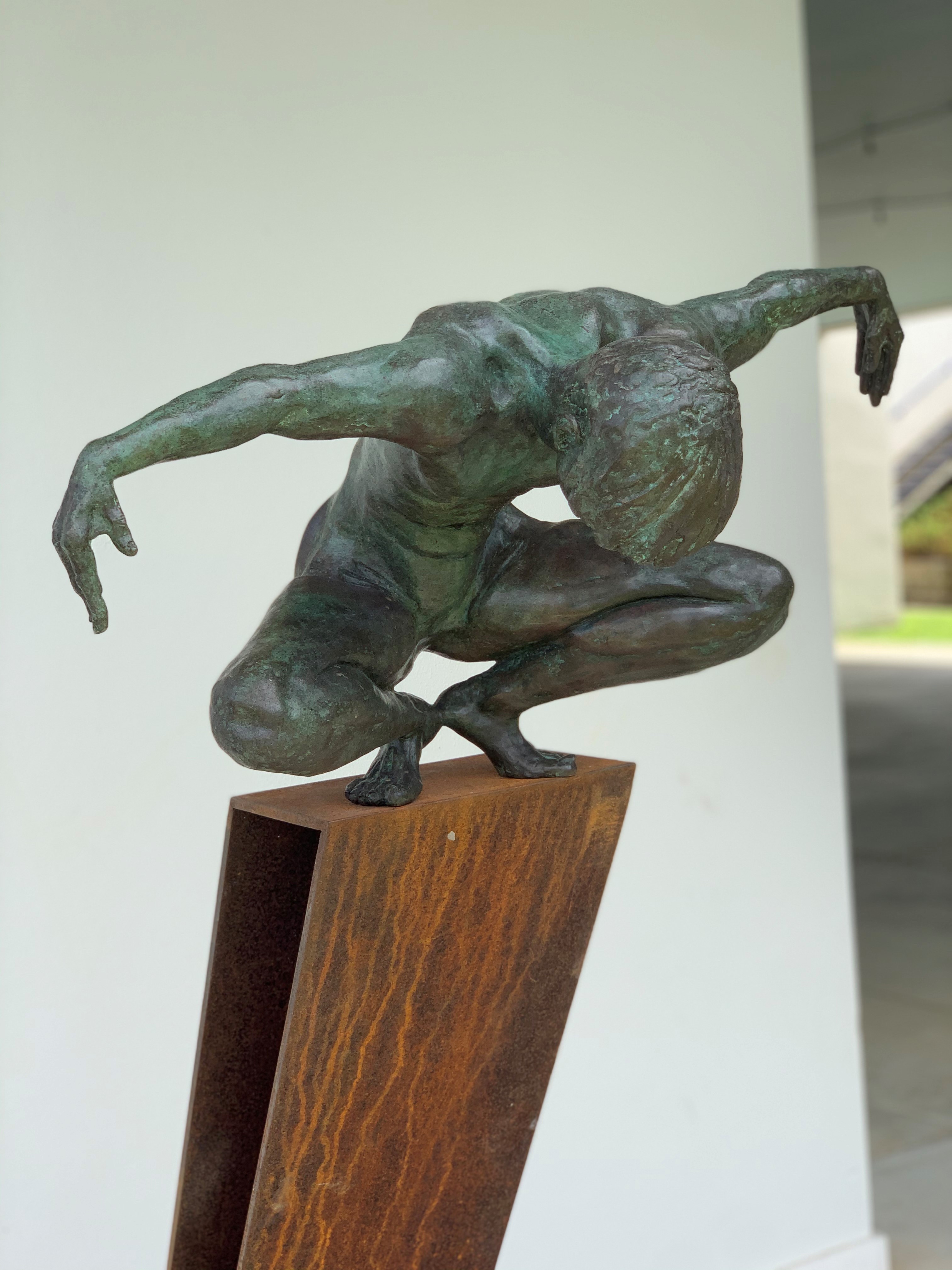 Narcissus
Narcissus
Teresa Wells, MRSS (United Kingdom, 1974 - )
A member of the Royal Society of Sculptors, Wells creates works that showcase her technical mastery as well as her philosophical exploration of the human condition. She is particularly intrigued by the impact of social media platforms on contemporary culture. She has noted that vanity and arrogance, typically seen as negative traits, are celebrated in the era of the ubiquitous selfie and the aspirational images shared online. Through Narcissus, she explores the idea of a vain individual who falls in love with his own image, although in contemporary culture the mythological figure is less likely to stare into a body of water than to drown in the endless promotion of his own image online. Narcissus, cast in bronze, perches precariously atop a sharply angled steel plinth. With his arms outstretched, he struggles to maintain his balance – physically and emotionally – while coping with isolation and detachment from his true reality. Wells’ work appears in public and private collections across the United Kingdom.
Two By
In "Two By" North Carolina sculptor Robert Winkler combines artistry and engineering to create an architectonic wooden structure that asks viewers to consider the intersection of natural beauty and human creativity. The sculpture is an example of assemblage, a common sculptural technique in the mid- to late-20th century in which the artist combines existing or created parts into a new work of art. Which other sculptures in the garden are examples of assemblage?
Duende
William Wareham's "Duende" derives its title from a Spanish artistic term that suggests a heightened state of emotion, expression, and authenticity. The California artist has clocked the steel sculpture in a unifying layer of white paint, and its placement in front of a magnolia grove was no accident. If you're not viewing the work while the magnolias are blooming, image the scent of the blooms and their white petals as a backdrop to this monumental work.
Domaine
"Domaine" by Chattanooga-based artist John Henry is a small example of the sculptor's long-term exploration of constructivist art. In Henry's work, rods and planes intersect, and the tension in those connections and the space around them form the artistic core of the sculpture. Henry's work often towers as high as 100 feet into the air, but "Domaine" presents his concepts on a scale where the viewer can examine it closely. Unlike his monumental pieces, which require multiple assistants and large equipment, Henry created this work exclusively on his own.
O Positive
In "O Positive," Chicago artist Michelle Goldstrom-Lanning gives a modern spin to the ancient art of bronze casting. The title refers to a blood type, and the artist has cleverly used large scale versions of blood cells in this sculpture. The textural elements on each piece mimic the appearance of blood cells under high-powered microscopes. If you look carefully, you can identify the items Goldstrom-Lanning used to create the texture. Here's a hint: they come from a very popular board game!
Axe
The clean distilled form of "Axe" by Southwest sculptor Frank Morbillo suggests that simplicity and scale make a potent combination. Like Brancusi before him, Morbillo abstracts an object by reducing it to its most basic forms. The smooth surface of the patinated steel is interrupted by a bronze insert that adds a textural point of interest and also reinforces the connection of the title to the object. What other works in the garden are composed of mixed materials?
Saturday Strut, Opening the Shut & On Tempo
Some artists use color or texture to give their ideas life. What does New York sculptor Judith Steinberg use? In her three aluminum sculptures here -- "Saturday Strut," "Opening the Shut" and "On Tempo" --Steinberg explores form. By limiting her palette to only white in these works, she emphasizes the way she has shaped the material, allowing the viewers eyes to explore where she cut and bent the aluminum. Do these sculptures remind you of anything you find in everyday life? What do Steinberg's titles tell you about what she had in mind as she made the works?
Honky Tonk
Canadian sculptor Ryan McCourt is part of a rich tradition of welded steel sculpture that flourished at the University of Alberta. Compare his "Honky Tonk" with Roy Mills' "Blue Slide." Both are composed of pieces of metal welded together. How are they different? McCourt's body of work focuses on using found objects to create a sculpture that is representational, in this case, a life-size upright piano. The rusty patina links the pieces together and gives the sculpture a vintage feeling as if it were found coated by dust in an old building.
Blue Slide?
What might have inspired the title of Roy Mills' welded steel sculpture "Blue Slide?" This is no playground slide. The interaction of the pieces Mills has yoked together suggests an avalanche moving down the side of a craggy mountain. A Canadian who spent extensive time in Japan, Mills is influenced not only by the welded metal traditions at the University of Alberta but also Japanese aesthetics and philosophy. Mills worked as an assistant to Sir Anthony Caro, and the great British sculptor's work is a major inspiration to Mills.
Simoon
The commanding presence of "Simoon" seems to perfectly echo the terrain of North Georgia, but Ken Macklin's striking work takes its names from the strong, hot, sand-heavy winds that blow across the Sahara and Arabian deserts. How does the artist create a work of several tons that evokes the wind? Look at the undulating forms Macklin chooses and how he suspends them between two open forms. The influential American critic Clement Greenberg hailed "Simoon" as a masterpiece when Macklin added the open forms that elevated the body of the sculpture. This work was the only piece in the rooftop sculpture garden of the Alberta Gallery of Art before taking its new home in Georgia.
Fallen
"Fallen" by North Carolina sculptor Kyle Van Lusk is a curious mix of industrial and spiritual concepts. The heavy steel the sculptor chose and the yellow industrial paint with which he accented it gives the impression of an object having dropped to earth and embedded in the soil. The strong vertical elements read as wings, however, and suggest the notion of fallen angels. The interaction of the sculpture with the earth itself also alludes to the Biblical fall of man. The beauty of abstract sculpture is that allows for as many interpretations as the viewer can imagine. What do YOU see in "Fallen?"
Inner View Deeper
Austrian sculptor Caroline Ramersdorfer has placed work on four continents and her work was prominently displayed at the Beijing games. "Inner View Deeper," like many of her pieces, is delicately carved from white marble. Ramersdorfer uses traditional tools like chisels and hammers and power tools to create her work, but she is intrinsically involved in the process from conception to completion. The final aspect of her work is the experience of the viewer, which informs the work with its purpose. As you look into the panels that make up "Inner View Deeper," of what does the work make you think? Of what does the experience remind you?
Split Circle
Oregon-based artist Troy Pillow's "Split Circle" introduces a bit of color and movement into the sculpture garden. The spinning discs make this a kinetic sculpture, a work that moves when it interacts with the wind. It's a whimsical work that brings to mind the sculptures of Alexander Calder and the drawings of Dr. Suess. As his title suggests, Pillow splits a circle to create the fundamental structure of this sculpture. What other works in the garden have a similar geometric foundation?
Spartan
The second work by Troy Pillow in the sculpture garden is "Spartan." In this piece, the artist suggests a tree, with some moveable components that could suggest autumn leaves or fruit. Which way do you see those red elements? As leaves or fruit? Why? The term "Spartan" today means barren, limited and without luxury. How does that term apply to this sculpture? If you compare and contrast "Spartan" and "Split Circle," which seems more sophisticated? Which seems more complex in its meaning? Why?
Mrs. Carter
Dalton sculptor Chris Beck's sculpture "Mrs. Carter," employs a common artistic device of depicting a person by presenting his or her clothes. (Jim Dine's self-portraits famously include only a bathrobe.) In this case, the artist has used metal to create the dress and ornamental flower of the woman who is the topic of his sculpture. If you were describing the unseen "Mrs. Carter" in words, what would you tell others about her based on Beck's choice of dress and flower? Do you think that the artist provides enough clues to make this a portrait? If not, what else would you add?
Roots II
Michael Little's "Roots II" is a segmented steel sculpture, which makes variable installations possible. Just as a tree's roots may grow in unpredictable directions, Little's sculpture allows a curator to position the two sections in many different configurations. Note that many of the segments that comprise the roots are not full circles. Little allows the viewer to see inside the root, which adds a visual dimension to the work but also creates the functionality of movement. Little lives and works in Maryland.
Rambler
"Rambler" is a complex sculpture with strong organic content that belies its welded steel construction. Though the work is totally stationary, Kevin Shunn has created the sense of potential movement with the work's foot-like projection and the heavy base with root-like steel rods emerging from it. Inside the cage-like mid-section of the sculpture, Shunn originally enclosed a wooden branch, shaping the metal around it. The wood is designed to disintegrate over time, with the exposure to the elements, heightening the sense that the sculpture is undergoing an evolution.
Ritual Totem
The ability to create works of art from discarded elements is not only a "green" practice but it challenges the artist and the viewers to see those objects in new ways. In "Totem" by Oregon sculptor Aimee Mattila, used tires are stacked and the tread is painted to give them fresh associations. Why might Mattila choose metallic paints for the tires? Look at the tread on other tires to see what inspires those patterns. Mattila tops her stacked tires with a crowning object made from metal strips and household items. Many people think of art as being important and distant. What does a sculpture made of discarded items make you think about the nature of art?
Untitled
Jordan Phelps grew up at Dalton and studied sculpture at the University of Georgia. His untitled work here in the garden is an example of using welded steel plates to create a work with significant volume but not significant mass because the work is hollow. Phelps doesn't offer viewers a title as means of connecting the viewer with the sculpture. Based on its appearance, what might you title this work? What ideas do you think that Phelps was exploring in creating this work?
Spreader
California artist Guy Dill has placed work in many North American museums and public spaces. "Spreader," Dill's monumental black work here in the sculpture garden, is typical of the artist's work in the mid-1990s. Against a grid, Dill places a number of geometric elements, creating a harmonious arrangement of curves, circles, and crescents. Dill encourages the viewers' eyes to follow along with the pattern he has created, allowing each person to consider the elements individually and how they work in concert. What other sculpture on the grounds reminds you of Spreader? How do they compare and contrast with one another?
Octetra
Highly regarded Japanese-American artist Isamu Noguchi is responsible for a significant body of sculpture that is a part of the 20th century's artistic canon. Widely displayed in museums around the world, the late artist's foundation maintains an exhibition space and sculpture garden in New York City where a representative sampling of his sculptures can be seen.The piece on the Guild's grounds is made from cement poured into molds and was originally intended for use in playground installations that Noguchi planned for cities in the US and Japan. The work is comprised of sections and can be positioned in several ways. Noguchi's balance of natural and industrial forms is a key to his place in art history, and this piece is a fine example of the artist's later work.
Untitled
The untitled work by Carl Billingsley is representative of the artist's minimalistic style. Billingsley creates work in many mediums, and in his welded steel constructions he seeks to express concepts within an intentionally limited artistic vocabulary. This form's strong vertical inclination and its simple, elegant angles complement the existing surroundings. As with many pieces of this type, there is no "message" or "meaning." The object is simply a construction and can be viewed only as such, with no more meaning--and no less meaning--than utilitarian objects. What other works in the garden have a minimalist appearance?
Ete
Ete is the smallest sculpture in the garden. South Carolina sculptor Gwen Marcus uses scale as a means of instilling her work with charm and delicacy. Some artists work in monumental scale because size is critical to the themes of their work. With Ete, Marcus offers a sensitive and contemplative rendering of a young girl where the scale of the work accentuates the figure’s expressive face and subtle gestures.
Field Labrador
Born in the Ukraine and a resident of Paris before becoming a citizen of the new Israeli state, Chana Orloff sculpted portraits of some of the most important artists and politicians of her day. She also loved animals and sculpted many dogs, birds, and fish. She treated animals with the same respect as her famous portrait sitters. Orloff's work is figurative, but the sculpture's surface illustrates her looser interpretation of her subjects. She focuses on general form rather than carefully addressing details. If you look closely at this alert and poised Field Labrador, you'll see that Orloff has given him a strong personality and a noble bearing. He is certain to become a favorite of everyone who meets him.
Les Trois Soeurs
Vladimir Montufar's Les Trois Soeurs or three sisters seem to float on air, an illusion the artist creates by casting the work in sturdy bronze with only the sisters’ feet touching the base. The artist, born in El Salvador but a resident of France for many years, often explores themes of families and interpersonal relationships in his work and captures the personality of his subjects through a loose, figurative style. Rather than creating a specific portrait, he offers a general observation on the relationship of these sisters. Notice how the figures bear a physical remembrance to one another while each retains her own identity.
Affirmation
Chattanooga-based sculptor Jan Chenoweth reclaims materials and reinvigorates them as components in her work. An assemblage artist, she has the rare gift of yoking together a sculpture unified in theme and content from disparate pieces with no easily identifiable common past. Her work Affirmation is marked by an appreciation of color and texture, which she may apply, create or assimilate from found objects.
Seedling
Kentucky artist Don Lawler's elegantly carved Seedling uses scale to help people see a familiar object--a germinating seed--from a fresh perspective. Due to its monumental scale, viewers can appreciate the beauty of nature's progress in greater detail. The work is carved from pink Georgia marble and uses the striations of the stone to great effect. Seedling has significant symbolic meaning for the Creative Arts Guild as it references the important work done by the Guild's founders to launch the institution.
Mr. Wrinkle's Favorite Speedwagon
Flintone, Georgia, sculptor Verina Baxter combines bright colors and an appealing composition to imbue Mr. Wrinkle's Favorite Speedwagon with a sense of whimsy. The sculpture is from a series of works on wheels that Baxter calls "Tumpkins." The artist coined the word, which suggests her own sense of originality and her free spirit. The height and precise construction of this work reflects Baxter's mastery of the technical aspects of sculpture as well as her ability to create work that appeals to multiple generations.
Sundrop
Talented sculptors transform the properties of their materials. Tennessee artist Davis Whitfield's Sundrop is made from steel, but the artist creates an impression of delicacy and playfulness with the gestural nature of the work. The pastel yellow and the extended "rays" of the sculpture evoke memories of the familiar song from The Sound of Music that references a "ray" as a "drop of golden sun." Whitfield's sculpture challenges the intellect and stimulates the imagination with its graceful form and technical excellence.
William Tell
Maine artist James Wolfe's sculpture alludes to William Tell, a legendary Swiss archer who led a rebellion against a cruel and oppressive king. When the king's soldiers captured Tell, the king forced the archer to prove his marksmanship by hitting an apple placed on the head of Tell's young son. Tell split the apple and then sparked the final uprising that overthrew the king. Elements of the sculpture suggest both Tell's bow stick and a small apple. The bright red of the sculpture references bothTell’s apple and perhaps the high price many rebels paid to bring freedom to their people.
Cut Buckle
Rob Willms' influences include art history, religion and myth and the topography and culture of his native Canada. In fashion terms, a "cut buckle" is a buckle where the plate is pierced to create a design, a common item found among the cowboys of the Alberta prairie. Rather than piercing, Willms has welded together pieces of steel so that the visual interest is created by undulating forms. While steel is often associated with density and strength, Cut Buckle demonstrates that in the hands of a talented artist, material can be adapted to a new vocabulary. Cut Buckle is part of a rich welded steel tradition at the University of Alberta in Edmonton where Willms studied.
Trojan Taurus
To stealthily lay siege to the walled city of Troy in the middle of the night, Greek soldiers hid inside a mammoth wooden horse left outside the city gates. Like that legendary horse, Canadian sculptor Rob Willms' Trojan Taurus is hollow, an artistic choice that allows Willms to give his sculpture monumental scale. When viewed from the front, one can see the triangular face and jutting horns of the titular bull, while the sides of the work offer interesting contrasts, with one open and sheltering and the other daunting and foreboding.
Donde Sera Sera, Quien Sera Sera & Que Sera Sera
These three maquettes Donde Sera Sera, Quien Sera Sera and Que Sera Sera by Canadian artist Rob Willms illustrate how sculptors explore a theme and work through different models to best articulate it. Que Sera Sera, or "what will be, will be" is a colloquial expression in both Spanish and English. Willms explodes that phrase by considering not only what will be but how and where it will be. The sculptures become tangible representations of these ideas around destiny and fate, variations that allow the artist to consider alternate compositions that best identify the solution to the challenge that the artist has set out for himself.
Sleight of Stature
Canadian sculptor Rob Willms understands his place on the art historical continuum. His work is informed and influenced by not only classical works and the Cubist tradition, but also by the rich heritage of welded steel sculpture that made Edmonton one of the leading centers of modern art. Willms demonstrates that a sculptor uses many tools to craft his art, words among them. In Sleight of Stature, the word "sleight" refers not a small scale but rather to trickery. "Stature" is a play on the word "statue" since the piece has a figurative quality, possibly referencing the Venus de Milo with her flowing skirt. Stature also refers to one's standing or level of accomplishment, so perhaps the artist is suggesting that he is elevating his own artistic stature by alluding to the form of one of the most recognized sculptures of antiquity as well Cubism, the dominant art movement of the early 20th century.
From Conception to Completion:
On October 22, 2010 the Creative Arts Guild opened its newly installed Robert Webb Sculpture Garden, a collection of contemporary outdoor artwork. According to the International Sculpture Center website, the collection represents Georgia’s first permanent sculpture garden or park.
The Robert Webb Sculpture Garden contains works by mid-career and internationally acclaimed artists including Michelle Goldstrom-Lanning (Illinois), John Henry (Tennessee), Ryan McCourt (Canada), Royden Mills (Canada), Frank Morbillo (New Mexico), Troy Pillow (Washington state), Caroline Ramersdorfer (Austria), Judith Steinberg (New York), Kyle Van Lusk (North Carolina), William Wareham (California) and Robert Winkler (North Carolina).
Through the generosity of local arts patrons George and Rhenda Spence, a vintage Isamu Noguchi sculpture will also be sited on the Guild’s grounds. Works by Georgia artist Kevin Shunn, Maryland’s Michael Little, Oregon’s Aimee Mattila and Georgia’s Jordan Phelps remain a previous Guild exhibit.
Robert Webb worked on the acquisition of pieces for the sculpture garden for some time which prompted the dedication of the sculpture garden in honor of his many contributions to the Guild in addition to the creation of the sculpture garden.
About Mr. Webb
Webb is a former three-term chair of the Guild’s board of directors and a current trustee at the institution. He is the founding editor of Emory University’s 20-year-old national literary journal, Lullwater Review, and a widely published poet, essayist and critic. Webb was the 1991 recipient of a Georgia Council for the Arts individual artist grant in poetry and, as an Emory senior, won a Louis Sudler Prize in the Arts as one of the top fifteen student artists in the US. He is a collector of modern and contemporary art and has offered guidance and support to emerging artists throughout the Southeast. Webb currently works as senior director of people and performance at Mohawk Industries and volunteers his time and talents with a number of local non-profits.
In 1993, Webb was instrumental in creating a temporary outdoor sculpture exhibit at the Guild, which was curated by world renowned artist John Henry. The commitment to making the arts accessibility to everyone has been a part of the Guild’s philosophy since it was established in 1963.
